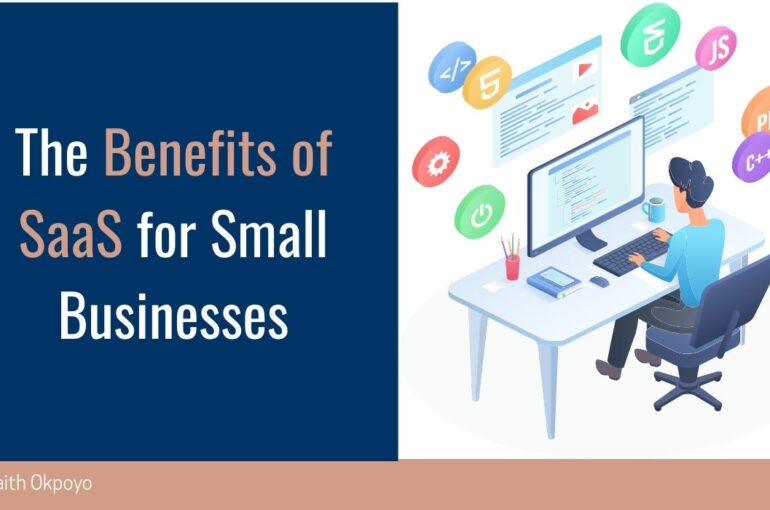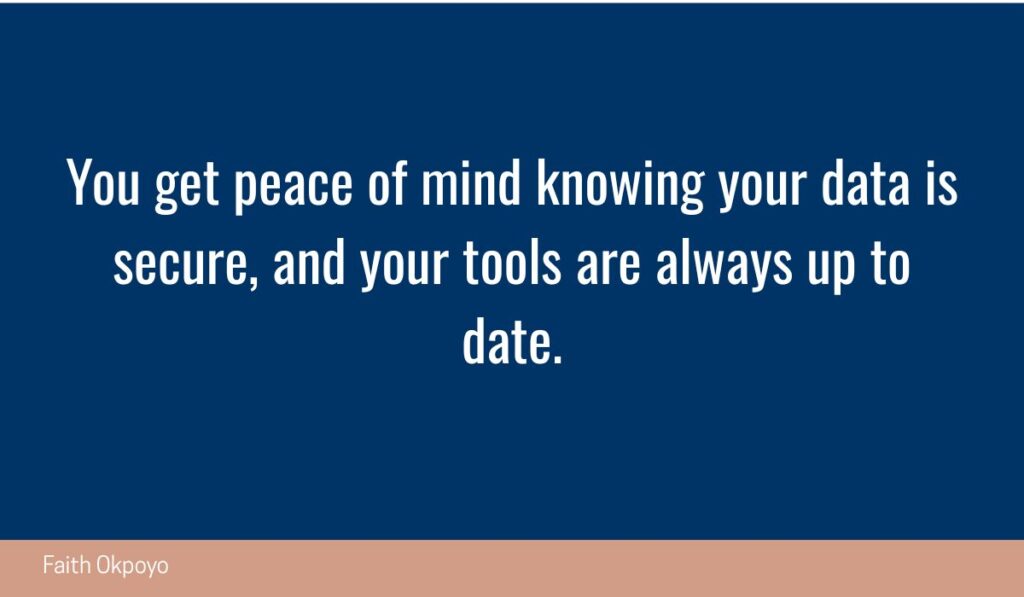The Benefits of SaaS for Small Businesses
The Benefits of SaaS for Small Businesses

When I started writing on WordPress in 2018, I knew nothing about SaaS. Literally. But all that became a thing of the past when I started reading SaaS blogs and editing technical content a few years ago.
My findings piqued my interest: SaaS wasn’t just for developers or tech-savvy folks; it was also for business owners.
If you run a small business or plan to, you’ve probably come across SaaS solutions, too. But what exactly is SaaS? How does it work? And more importantly, what are the real benefits of SaaS for small businesses?
That’s what this blog post is all about. Ready? Let’s break it down.
What is SaaS?
SaaS simply means Software as a Service. It’s a system of hosting software applications in the cloud. It also offers the luxury of not having to download or install it. As long as you’re connected to the internet, you can use the app from anywhere.
Businesses now use SaaS for customer relationship management (CRM), resource planning, project tracking, backup solutions, and more. It’s become essential for individuals and companies.
How SaaS Differs from Traditional Software Tools
Traditional software, such as Microsoft Word or Adobe Photoshop, is typically installed directly on your computer. It works there, but it needs to be updated manually and requires an upfront cost, such as licenses, equipment, and IT setup.
SaaS, on the other hand, is cloud-based and uses a subscription model. The provider handles installation, updates, security, and maintenance from their servers. This makes it easier and more affordable for businesses, especially small ones, to access powerful tools without spending much money. Popular SaaS tools include Slack, HubSpot, and QuickBooks.
Benefits of Using SaaS Tools
Below are some reasons why you should take advantage of SaaS tools:
1. Cost Effectiveness
One of SaaS’s striking advantages is its affordability. Simply put, it helps reduce costs. Instead of investing a large sum of money upfront, you can subscribe to your chosen software on a monthly or annual basis.
Also, you only pay for what you use. For example, instead of installing a full-fledged CRM tool in your office, you can choose cloud-based services like Salesforce and scale as you wish. This pay-as-you-go model helps small businesses manage cash flow and reduce financial risk.
2. Scalability and Flexibility
SaaS tools are built to scale with your business. As your business becomes bigger, you can add or remove users, upgrade features, integrate new tools, expand storage, and even enter new markets without needing to overhaul your system.
In terms of flexibility, SaaS platforms can adapt to your size and goals, whether you have three employees or 30. That’s really something to pay attention to.
3. Accessibility and Remote Work
Because SaaS tools live in the cloud, your team, whether hybrid or remote, can use them as long as they’re online.
Some key benefits include:
- 24/7 access to business apps
- Real-time data syncing across devices
- Seamless collaboration from anywhere
- Improved work-life balance for employees
4. Storage Security and Maintenance
SaaS providers handle security, updates, and system maintenance for you. That means small businesses get enterprise-level protection without having to hire a dedicated IT team.
This typically includes:
- Data encryption
- Security patches and updates
- Automatic backups
- Disaster recovery systems
- Industry-standard compliance
You get peace of mind knowing your data is secure, and your tools are always up to date,

5. Better Collaboration and Productivity
SaaS tools make teamwork smoother than ever. Slack, Microsoft Teams, and Google Workspace support real-time document editing, instant messaging, video calls, project tracking, and file sharing.
Teams remains connected, whether they’re working in the same office or remotely, with these features.
6. Industry-Specific Solutions
Many SaaS platforms can meet the unique needs of different industries, including yours.
For example:
- Retail: Tools like Shopify, Square, and Lightspeed can help small businesses in the retail industry streamline operations, manage inventory, and process payments.
- Healthcare: Businesses in the health-care industry can leverage Practice Fusion, Zocdoc, and SimplePractice for electronic health records (EHR), appointment scheduling, and patient management.
You see, these tailored tools make it easier for businesses to run smoothly.
7. Automation
SaaS tools often come with built-in automation features that reduce manual work. You can automate tasks like:
- Sending email campaigns
- Scheduling social media posts
- Creating invoices and processing payments
- Backing up data
- Generating reports and performance insights
Automation frees up time, which allows business owners to focus on strategy, growth, customer relationships, and other key priorities.
8. Low Barrier to Innovation
SaaS makes it easy to explore new technologies without major upfront costs. Many platforms, such as HubSpot, offer free trials. The goal is for businesses to experiment before making a financial commitment.
SaaS subscriptions are flexible. You can scale up, switch plans, or change strategies as needed. For example, a small retail business might start with a basic Shopify plan and then upgrade to a more advanced one.
A Real-World Success Story
I’ve noticed, first-hand, how much SaaS tools can change things for the better for small businesses. And the results speak for themselves.
Take the Databox case study. A small marketing agency used the platform to automate client reporting. They eliminated manual data gathering and report creation, and as a result, they saved up to 40 hours each week.
This story shows just how powerful and practical SaaS can be for your small businesses.
How to Choose the Right SaaS Tool
Here’s a practical guide to help you make a wise choice:
Understand Your Business Needs
Start by clarifying your business needs. Pinpoint the challenges you want to solve, separate the must-haves from the nice-to-haves, consider your growth plans, and set a budget you can stick to. It’s that simple.
Prioritise Security and Compliance
Security should never be an afterthought. Choose tools that offer:
- End-to-end data encryption
- Compliance with industry standards like GDPR
- Regular security updates
- Automatic data backups
- Multi-factor authentication
Review the Pricing Model
Figure out exactly what you’re paying for. Compare features across pricing tiers, watch out for hidden fees, understand your usage limits, and make sure the value justifies the cost.
Evaluate Support and Training
Good support makes a big difference. Look for:
- Multiple support channels (chat, phone, email)
- Responsive customer service
- Helpful tutorials
- Access to forums
Conclusion
SaaS has changed the game for small businesses. Some expensive tools have now become affordable for small business owners.
So, if you’re trying to grow your business or work smart, SaaS can help. It’s not just a trend; it’s a real solution that enables you to scale.
Learning to embrace the right SaaS tools could be one of the smartest moves you make.




Stephen Ukah
This is lovely and eye opening. Well done and keep the good work up.
Faith
Thank you, Sir.
Joshua Adams
This is awesome
Gift Favour Nnamani
I love how understandable and clear this is. If I didn’t know what SaaS was before now, this would have clarified it for me.
Correct me if I’m wrong though, but Adobe Photoshop now offers SaaS through their Creative Cloud.
Bukola Dike
Impressive! This is highly educative. You did justice to the concept of SaaS explaining terms in clear and simple English.
Gift Imasuen
This is worth reading. Thanks for this.